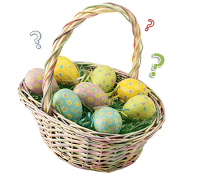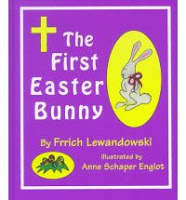Ask anyone what they think of when they think of Easter, and you’ll probably get answers like, “Easter bunny”, “Easter basket”, “bonnets”, “eggs”, and “candy”.
…but did you ever wonder how (or when) these symbols became the top-of-mind answer for so many people, both Christian and non-Christian alike? …and where do things like: “empty tomb“, “resurrection”, and “died for our sins” fit in? I mean, how did the Easter bunny become a symbol of Easter?
I spent some time researching this online, and found a ton of information. With all the info available, and trying to stick to the most reputable sites, we can get a feel or where many of our traditions of today came from. What is interesting to me is how many of today’s well-marketed Easter activities actually find their roots in pagan traditions. Personal thoughts on this are that it’s important to know why these images are (or are not) used in our in-home celebrations today. This is actually one of the things hubby and I wrestle with – how to raise our son with a strong Christ-centered faith when so many of our Holy Days are bombarded (and warped) by mass marketing. Our adopted motto has become: “if you can’t beat them, join them…just understand & know why you join so you can explain”. To help best understand, I’ve broken down some of the most common symbols in the table below, with a look at a) the earliest known origins, b) how it became part of Christian tradition, and c) ways you can take the tradition and make it Christ-centered today.
| Early Origins | Christian Origins | Applying it Today | |
| Easter Baskets | (see Christian Origins) | Early Catholics, most commonly those in Eastern Europe, would bring a basket of the food to be eaten on Easter Sunday to church to have it blessed. Known in Poland as Święconka, baskets are lined with a white linen or lace napkin and beautifully decorated. The breads, meats, butter, salt, and eggs found in the baskets of then have evolved into the candy, chocolates, and treats of today. | Find a parish in your area that does an Easter Food blessing. Have your family help prepare a basket with the foods your family will be eating this Easter and take it to be blessed. on Easter Sunday, make the association to your children between their Easter baskets of treats and the basket of food you just had blessed. Another great idea: fill the basket with some faith treats like candy lambs and chocolate prayers, or faith-inspired pretzels and hot cross buns! |
| Easter Eggs | Eggs are seen throughout history as a symbol of new life and have been decorated forever – seriously. The earliest decorated egg pre-dates Christianity by about 58,000 years, with the oldest decorated egg being found in Africa. | The egg itself was incorporated into Christian tradition as a symbol of Christ in the tomb – just as Jesus emerged from the tomb, so too does the chick (new life) from an egg. The decoration of the egg likely became a part of Christian tradition when early Christians of Mesopotamia dyed eggs red to represent the blood of Christ. The plethora of eggs seen on Easter Sunday is likely a result of Lent – as mentioned in an earlier post on Mardi Gras, eggs used to be on the “no-no” list during Lent, which led to a natural build-up of eggs to be eaten on Easter Sunday. Hard boiling the eggs was a natural preservative – another tradition that carried through to today. | The early-Christian origins of the egg are a great way to build faith learnings with your family. Teaching that Jesus was (re)born from the tomb, much like the chick is from the egg, is a concept even very young children will understand. When dying your eggs, talk about what a wonderful celebration God’s love is for us and how we want to make things even more beautiful to celebrate that love through Jesus’s resurrection on Easter Sunday. Be sure to bring some of your colored eggs to the basket blessing! |
| Easter Bunny | European hares are prolific breaders, with the females often being able to conceive a second litter while still being pregnant with the first (source). Crazy, right? This mama says NO THANK YOU. That being said, it’s no wonder they were seen as a symbol of fertility and birth to early pagans who celebrated Vernal Equinox. | Interestingly, there were not many articles detailing how the rabbit became a part of Christian tradition. Most spoke to how the hare itself started as a symbol of fertility and was honored at Vernal Equinox…as the pagans became early Christians, the rabbit continued its “celebrity status” into Easter, which falls at near the same time as the Equinox.
One article did speak to the rabbit, when seen in Christian churches, as being representative of the Holy Trinity. |
We received a copy of The First Easter Bunny by Fr. Rich Lewandowski at our son’s baby shower. Both the book and DVD beautifully tell the story of the “first” bunny who witnessed the Passion, Death, and Resurrection of Jesus. It’s meant for children, but is a simply wonderful story for all! |
What other symbols of Easter come to mind for you? Do you have more information on any of the origins noted above? I’d love to hear how you bring commercialism back to faith-centered in your homes when celebrating Easter. Thanks for sharing!
Note: this article also appears on Catholic Carnival .


Hi Jen, it is so interesting how pagan practices can be found in the history of Easter Symbols. I recently did a post on Easter Symbols, but just the symbol. I sent home with my students the reasons behind them. I included the cross, lamb, lily and butterfly.
It *is* interesting, isn't it? I think that was what surprised me the most…the (very historic) tie to pagan practices.